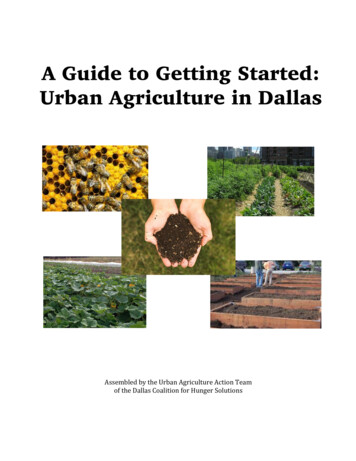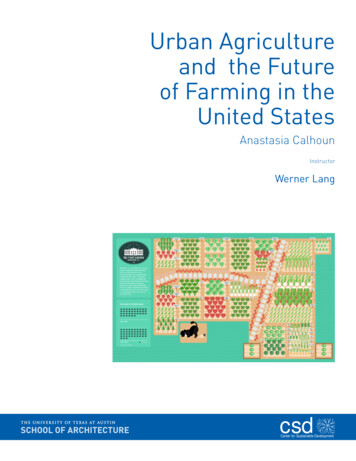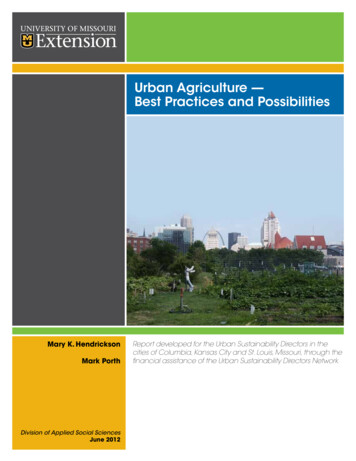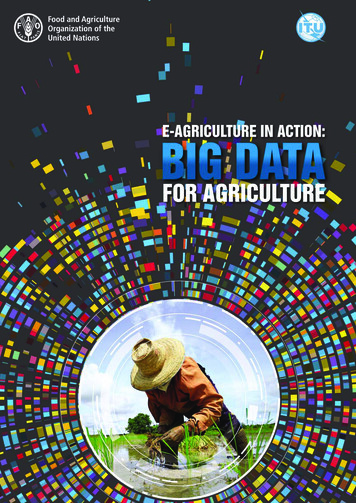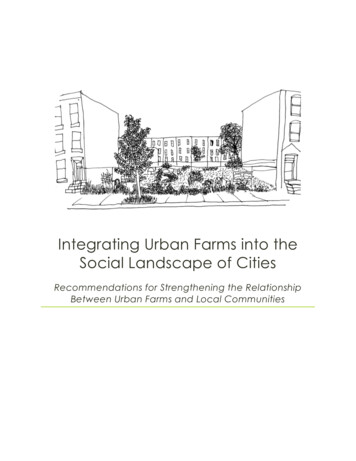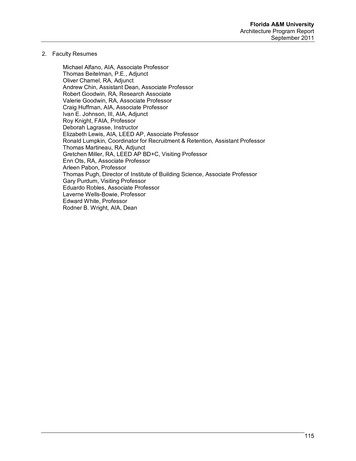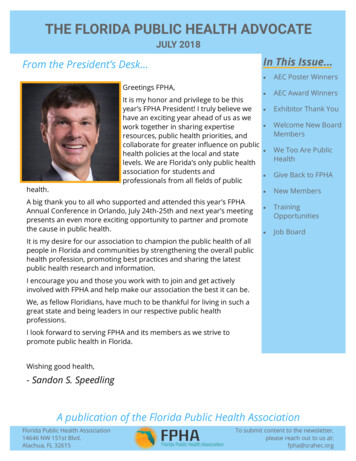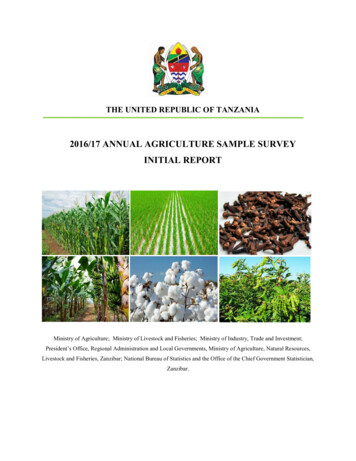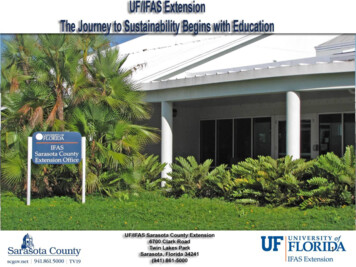
Transcription
1
Urban agricultureA Participatory, Primer CoursePart 2a: Business PlansRobert onSarasotaCounty 2
Outline Short Review of Course Syllabus World Café Exercise Introduction to Business Planning Two online manual resources Introduction to Market Planning Niche marketing3
Urban Agriculture Certificate CourseClass Topics Sequence #1: Introduction and ProductionSystems #2: Business and Marketing PlansToday’sTopic #3: Regulations and Direct Markets #4: Equipment and Tools; Post HarvestHandling #5: Financial Resources &Management4
Urban Agriculture Certificate CourseWorkshop Topics Sequence #1: Container and Hydroponic Growing #2: Frost Protection and IPM #3: Farmscaping w/ Cut Flowers #4: Farm Food Safety Plan #5 Composting and Renewable EnergyTechnologies5
Introductory Activity (10 min.) World Café Format Collaborative Respectful Answer the following: What is your model ofprofitable urban agriculture? How does it reflect your visionfor a successful urban farm? Form groups of 4 persons. Appoint 1spokesperson to take notes and report out to theclass on your group’s responses, using bulleteddescriptors.6
Urban Agriculture Questions Is it really a moneymaking enterprise? Is there a rolein a modern urbanfood system?7
Profitable Urban AgricultureMaybe You Have Seen These Book Titles . . . “Earn 36,000 in a single year from lessthan one full acre”- Backyard Market Gardening: TheEntrepreneur’s Guide to Selling What You Grow 16,5000: Potential Income in aHoophouse (24,00 sq ft)– You Can Farm: The Entrepreneur’s Guide to Startand Succeed in a Farming Enerprise8
Profitable Urban AgricultureMaybe You Have Seen TrendingFor-Profit Urban Farm Programs . . . Watch these short videos: “Grow Food, Make Money” – seehttp://www.spinfarming.com/buy/ “Urban Farming, SPIN Farming - Small Plot INtensive UrbanFarming Production System to Create Income” - seehttps://www.youtube.com/watch?v BsJeDZr9MI4&t 472s9
Profitable Urban AgricultureOr Successful Non-Profit Urban Farms . . .Fairview Gardens Organic Farm Center for atch the short video “Beyond Organic - The Vision of Fairview Gardens(Bullfrog Films clip)” – seehttps://www.youtube.com/watch?v oHixPUgysWI10
Profitable Urban AgricultureOr Trending For-Profit Urban Micro-Farms . . . Watch these short videos by the Urban Farmer Curtis Stone: “THIS IS HOW MY FARM WORKS! - 100K on a quarter acre” –see https://www.youtube.com/channel/UCBlDCX nCLs ZF9meYQbw “Ask The Urban Farmer -- 300K on an acre. To scale or not to11scale?” – see https://www.youtube.com/watch?v axMbB-HmeSY
OK, That’s All Fine and Dandy.Now How Do I Get Started inUrban Agriculture?12
Urban Agriculture Initial Steps Assess Your Situation available resources and challenges urban environment factors Develop a business plan for the start-up andoperation of the business regardless ofwhether it is intended to be a for-profit businessor a non-profit business. Learn the urban market factors in order todevelop a marketing plan for farm-business-plan-handbook
Assessing Your Situation S.W.O.T. AnalysisStrengths (S) What the organization does wellWeaknesses (W) What is done poorlyOpportunities (O) External events, that if takenadvantage of, could improve the organizationThreats (T) External events, that if notaddressed, could harm the organization S.W.O.T. needs to be an .gov/pdf/swot brochure web.pdf
S.W.O.T. Analysis Description Once all of the strengths, weaknesses, opportunities,and threats to the farming operation have been listed,the information should be combined to give an overalllook at the current position of the farm and developfuture strategies and to manage the operations Developing strategies that focus or capitalize on thestrengths of the operation. Develop strategies that will strengthen the weak areas& threats by taking advantage of strengths andopportunities to counter or reduce wot-15analysis#.VgqUz lViko
Assessing Your Situation16
‘S.W.O.T.Analysis’Template17
S.W.O.T. Urban Farm StartupExample Strengths Familiar w/ the local foods movementExperience w/ sustainable vegetable gardeningPeople skillsFamily support Weaknesses Experience in rural crop growing up north but not FLNo direct marketing experienceLimited access to land and equipmentLimited finances18Unsure of urban consumer food preferences
S.W.O.T. Urban Farm StartupExample Opportunities Demand for local, fresh, nutritious foods is increasing Local educational resources Increasing number of direct markets, e.g., farmersmarkets, restaurants, etc. Farmers Markets & FL Organic Growers associations Threats Competition – from FL agribusiness and retailers Challenges of FL growing conditions & urbanenvironment Slow economic growth Regulations and certification19
S.W.O.T. Urban Farm ExampleExample Strategies Start at micro-farm/backyard scaleBuild upon successes to scale up to farm sizeIdentify and address education needs of farm teamDevelop business and market plansVisit local urban farms and meet local farmersDon’t give up your day job20
Urban Agriculture Business PlanWhat is Business Planning? On-going problem-solving process Identification of challenges and opportunities Application to the 4 key management areas– Marketing– Operations– Human resources– Finances Development of strategic objectives toachieve your vision21
Why Develop a Business Plan? Make regular marketing, operational, humanresource, & finance decisions To identify new market opportunities Pursue long-term personal, economic,environmental & community goals To communicate ideas to lenders, businesspartners and business stakeholders22
Who Needs a Business Plan? Everyone at Any Business Cycle Stage!– A beginning producer Evaluating startup enterprises and scale– An experienced producer Transitioning from conventional to organicsExpanding your operatonPlanning to incorporate family members/partnersConsolidating enterprises– A retiring producer Tranfer or sell the business23
Urban Ag Business Plan Before beginning the development of yourbusiness plan, think about the primary reasonsfor starting an urban farm. Documenting your reasons for starting the farmwill help you focus the business plan and identifythe issues, the resources and the expertise thatwill be needed to develop the business plan. Finally, think about the values that you bring tothe business and the values that are important tothe success of the business.24
Urban Ag Business Plan- Components 1. Identifying stakeholder values, vision, missionand goals2. Assess your current situation3. Organization and Management.4. Marketing Strategy.5. Operating Strategy.6. Financial Strategy.7. Strategic value & evaluation8. Implementation & monitoring9. Executive summary25
The Urban Farm Business Plan Handbook developed bythe Partnership for Sustainable Communities providesguidelines for the process of developing a business planfor the startup and operation of an urban farm. The handbook includes both food and non-food relatedagriculture and is useful for both non-profit and for profitfarms. Provides instructions and riculture/urban-farmerUrban Ag Business Plan Resource
“Urban Farm Business Plan Handbook”Overview An urban farm is a part of a local food system where foodis cultivated and produced within an urban area andmarketed to consumers within that urban area. Urban farms can take a variety of forms including nonprofit gardens and for-profit businesses. They can providejobs, job training, and health education, and they cancontribute to better nutrition and health for the communityby providing locally grown, fresh produce and otherproducts. In addition, urban farms can also contribute to therevitalization of abandoned or underutilized urban land,social and economic benefits to urban communities, and27beneficial impacts on the urban landscape.
“Urban Farm Business Plan Handbook”Overview Urban farms, present unique challenges that aredifferent from conventional agriculturaldevelopment. Developed land often has a history of uses thatmay require substantial site preparation, specialgrowing techniques, and/or policy support. The success of an urban farm may depend on adiversity of products and volunteer labor tosupport the start-up and initial operations.28
“Urban Farm Business Plan Handbook”Overview Urban farm development and operating practiceswill have to account for the proximity of residentialand/or commercial neighbors and the compatibilityof the farm operations with these neighbors. Urban farms can challenge traditional imagesresidents might have for how land is used in cityneighborhoods. Urban farming projects are mostlikely to survive and thrive if they make the effort tohave local support.29
Urban Ag Business Plan htm30
“Building A Sustainable Business”Overview Has a rural focus but still highly relevant for urban Agbecause it focuses on agricultural entrepeneurs who donot use “conventional” farming models. Objective is a business plan helps producersdemonstrate that they have fully researched theirproposed alternative; they know how to produce theirproduct, how to sell what they produce, and how tomanage financial risk. This guide is as much about the planning process as it isabout the creation of a final business plan. Provides instructions and worksheets31
“Building A Sustainable Business”Overview Unlike conventional approach Uses Holistic Management Concepts– Starts with and integrates personal, economic,environmental, & community values– Based on a ‘whole-farm’ approach– Adapts conventional business planning &marketing principles– Integrate values w/ business management32
“Building A Sustainable Business”Overview Holistic Management Definition A simple decision making process forfarmers to achieve: Improved quality of life Real wealth Agriculture design according to principles ofsustainability– Economics– Environment– Social A learnable skillhttps://holisticmanagement.org/33
Holistic Management34
Holistic Management35
Holistic Management Exercise“Mindmap Method” What is the Mindmap Method?– Technique for working with holistic processes– Promotes seeing connections beyond making alist of the parts– Procedure Start with an idea Associate ideas in any direction Add more association as you branch out36
Mindmap Method ExampleResources of a Family Unit37
“Holistic Management”Financial Planning Approach38
“Building A Sustainable Business”Overview Develop A “Holistic Goal”– Centerpiece that drives all decision making– Values based What are my motivations? What do I want to achieve? What do I want to leave for my family and/orcommunity?– Ensures objectives, goals and actions moveyou to what you want for quality of life.39
“Building A Sustainable Business”Overview How is the holistic goal achieved?– Appropriate use of tools Production planningLand planningBiological planningFinancial planning– Monitoring of decisions40
“Building A Sustainable Business”Overview How is the holistic goal achieved? the forms of production are identified. these describe what must be produced to achieve thisquality of life and not how it will be produced. how you do things are actions, and all actions are testedusing the monitoring guidelines. describe the future resource base of what the farm landand community must be like in the future to sustain thefarm. The future resource base also describes how thefarm and farmers must be perceived like by clients tosustain their business into the future.41
A Holistic Goal ExampleQuality of life: We desire a happy family, prosperousrural farm life, community harmony, freedom of religion,security, time for family and friends, good health, cleanfood & water.Forms of production: profit, tolerant environment, fulland meaningful employment, leisure time, unpollutedenvironment Future resource base: Landscape Effective waterand mineral cycling, high biodiversity and energy flowin crop fields. A sustainable agroecosystem withabundant wildlife. Clients/suppliers We must befriendly, professional, have a good attitude, beprompt & reliable, honest, open-minded, responsive 42
Urban Ag Business Plan To begin developing a business plan, definethe following components as a sequentialprocess:––––ValuesVisionMission StatementGoals43
Urban Ag Business Plan- Definitions Values– Standards, beliefs or qualities that you considerworth upholding or pursuing– Should be comprehensive personaleconomicenvironmentalcommunity– Identification is critical by all stakeholders44
Urban Ag Business Plan Values Examples– Importance of food choices, healthy diets and lifestyles,and nutrition education.– Foster a sense of community by reconnecting people withlocally grown foods.– Benefit public health and the environmental by cleaningup brownfields properties.– Develop sustainable reuses support communityeconomic, social, and environmental goals by utilizingoperation and production techniques that minimizepollution and conserve resources and providingopportunities for job training and education.– Provide affordable fresh fruits and vegetables.45
Urban Ag Business Plan- Definitions Vision is the “dream and inspiration”– Brainstorm & imagine the future– Include all stakeholders– Use different media representation in order tocapture general concepts, as well as specificexamples46
Urban Ag Business Plan Vision Examples– Economically viable source of fresh locally grown fruitsand vegetables and related products to ourcommunity.– Productive reuse of abandoned properties, local jobs,and job training.– Benefit public health and the environment by cleaningup and utilizing operation and production techniquesthat minimize pollution and conserve resources.– Providing nutrition education and job training.47
Urban Ag Business Plan- Definitions Mission statement is the “reason why”– Statement of purpose– Provide an overview of the business directionto realize your vision– General and short in length– Consider that others will see it as a reflectionof you48
Urban Ag Business Plan Mission Statement Examples– To promote the social and economic benefits of urbanfarming and the viability and sustainability of suchefforts.– To create an abundance of food for people in need bysupporting and encouraging the establishment ofgardens on unused land and space while increasingdiversity, raising awareness for health and wellness,and inspiring and educating youth, adults and seniorsto create an economically sustainable system to upliftcommunities.49
Urban Ag Business Plan- Definitions Goals are the “who’ and ‘what’– Basis of business strategies– Types PersonalFamilyBusinessCommunityEnvironmental50
Urban Ag Business Plan Goals Examples (short-term, 1-5 years)– Engage the community in the growing centeroperations and production.– Construct the initial hoop house and install the verticalgardens with initial crops in summer 2018.– Construct the farm stand and training center.– Bring the facility to its full anticipated productioncapacity consisting of four hoop houses, verticalgardens, a farm stand, a training center, and supportbuildings.– Sales will be to both local residents, transientresidents at the farm stand, and to local food servicebusiness.51
Urban Ag Business Plan Goals Examples (long-term, 5 years)– Expand the market to larger food service businesses suchas nursing homes, school lunch programs and expand thefacility to meet the needs of these additional markets.This would require the acquisition of additional property inthe area of the growing center.– Incorporate aquaponics into the production operations.– Add composting operations.– Additional products such as jams, salsas, and packagedsalad mixes.– The growing center will be able to off-set operatingexpenses with annual income and generate an annualprofit.52
“A Sustainable Business Plan”Strategic Planning & Evaluation Strategy: A careful plan or methodfor achieving an end.” This is a very important step in the process:––––Develop a business strategyEvaluate strategic alternativesDecide on the whole business strategic courseDevelop contingency plans53
“A Sustainable Business Plan”Strategic Planning & Evaluation The steps for developing a business strategyincludes:––––Develop a marketing strategyDevelop an operations strategyDevelop a human resources strategyDevelop a financial strategy54
“A Sustainable Business Plan”-Whole Farm Approach The System-wide Connections of theStrategies of the 4 Management Areas––––MarketingOperationsHuman resourcesFinances It Considers How Each Strategy AffectsEach Other55
“A Sustainable Business Plan” Decision makers need to decide?– Stay with current business plan– Adopt an alternative strategy– Reconsider new alternatives Consider Strategy “Best Fit” Tests–––––––Vision consistencyGoodness of fitBuilding for the futureFeasibility and resourcePerformance (especially for the ‘transition’ period)ImportanceConfidence Develop a contingency plan & exit strategy56
“A Sustainable Business Plan” Parts of a Monitoring Program– Make a “To-Do List” Assigned stakeholders Deadlines– Maintain Records– Establish “Checkpoints” Short time frame Evaluate “objectives”– Renew Full Circle of Planning Process57
“A Sustainable Business Plan”The Full Circle of Planning Process58
59
An urban farm is a part of a local food system where food is cultivated and produced within an urban area and marketed to consumers within that urban area. Urban farms can take a variety of forms including non-profit gardens and for-profit businesses. They can provi
